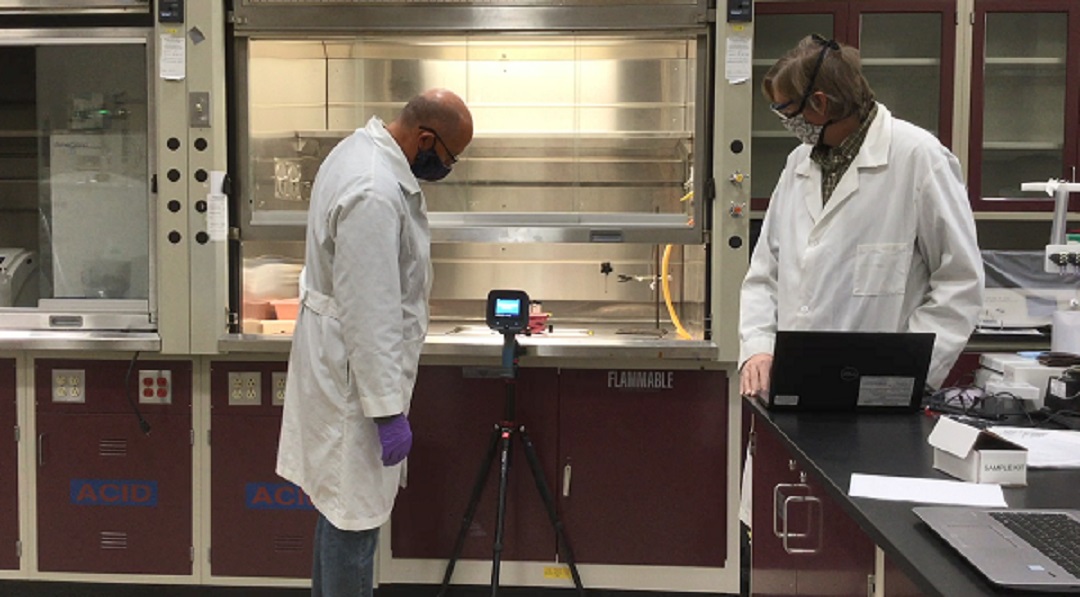// NEWS RELEASE
Army Experts Help DHS Develop Standoff Chemical Detection Capability
CCDC Chemical Biological Center Public Affairs | March 3rd, 2021
Army Experts Help DHS Develop Standoff Chemical Detection Capability
DEVCOM CBC Public AffairsMarch 3rd, 2021
Aberdeen Proving Ground, MD – Researchers at the U.S. Army’s Combat Capabilities Development Command Chemical Biological Center (DEVCOM CBC) have lent their expertise to the Department of Homeland Security (DHS) in a new standoff chemical detection effort.
Electrical engineer Dr. Phillip Wilcox and research chemist Dr. Jason Guicheteau, from the Center’s physical science division, were charged with the task of helping DHS expand their threat target library for a device that DHS will be using in their handheld standoff chemical detection (HSCD) pilot program. To achieve the mission, Guicheteau and Wilcox added chemicals that they have done extensive research on over the years to the DHS library, allowing HSCD devices to recognize hazardous chemicals from a distance which, separates users from potential chemical threats in the field.

For many years, this team of two helped organizations like DHS understand emerging chemical threats and how they work. In the pilot project, Guicheteau handled the materials, prepared samples and operated the instrument, while Wilcox focused on analysis and compilation of the data which he ensured met the quality standards before inclusion into the library. Additionally, Guicheteau acted as liaison between DHS and the vendor who builds the prototypes.
“To develop the library, we’ll take the target chemicals and put them in our fume hoods, which allows us to perform very long acquisition times to get high quality data,” Wilcox said. “Then, we give the data back to the vendor where they are able to incorporate it into their instrument so they can detect lower quality chemical targets that the instrument sees in the field.”
In this case, that instrument is the Pendar X10 device, a HSCD device. The goal of standoff detection is to identify hazardous chemicals from a safe distance. For example, a HAZMAT team enters a location where they suspect a threat. The team uses a HSCD, which is reminiscent of a cordless drill. In a swift motion, they simply point and shoot. The device emits a laser beam which indicates what chemicals are in the area. The technology can be used to detect illicit drugs or chemical threats and can be used by an operator in a handheld fashion or mounted on an unmanned ground vehicle.
Wilcox and Guicheteau’s reputation in the field of standoff chemical detection precedes them. In addition to DHS, Wilcox and Guicheteau have collaborated with Special Operations Command and the Joint Program Office for Chemical, Biological, Radiological and Nuclear Defense. Together they have many years of experience and a broad knowledge of general spectroscopy, making them the obvious choice to collaborate with DHS on this project. “Multiple DHS operational customers participating in our pilot effort will benefit from the work of Dr. Guicheteau and Dr. Wilcox. Their efforts, and those of the CBC in general, are much appreciated,” said Scott W. Jansson, DHS’s deputy assistant secretary for systems support.
Guicheteau noted that it’s rewarding to be involved in the development of technologies that help to protect Soldiers. “As part of the spectroscopy branch in the Center’s physical science division, we have a long history in optical spectroscopy detection work,” he said. “A lot of technologies have come through our door with collaborative partnerships with academia, small and large business, as well as other government agencies. We see early prototypes of these technologies and we get to be on the front lines of helping them develop so that they become solutions that deliver a capability to first responders or warfighters.”
In December, DHS received one of the prototype systems for their pilot program. They validated the system to ensure that the library data collected works and can detect the materials. Later this year, full acceptance testing will be performed to ensure that the 20 units delivered by the commercial vendor under the pilot program are functional and meet DHS’s requirements.
According to Wilcox, one of the main takeaways that the team gathered from this collaborative experience is the significance of working closely with users in the field. They were able to directly consult with users to assess their needs and potential hazards they might encounter. “We’re able to take user requirements and translate them into what is scientifically possible,” he said. “It’s very easy to be a lab person and get stuck in the science mindset of a project, so it’s nice to have feedback from the user to understand that we are using our abilities to solve their problems.”
The U.S. Army Combat Capabilities Development Command (DEVCOM) leads in the discovery, development and delivery of technology-based capabilities to enable Soldiers to win our nation’s wars and come home safely. DEVCOM is a major subordinate command of the U.S. Army Futures Command. The DEVCOM Chemical Biological Center is the Army’s principal research and development center for chemical and biological defense technology, engineering and field operations. The DEVCOM Chemical Biological Center is headquartered at Aberdeen Proving Ground, Maryland.
